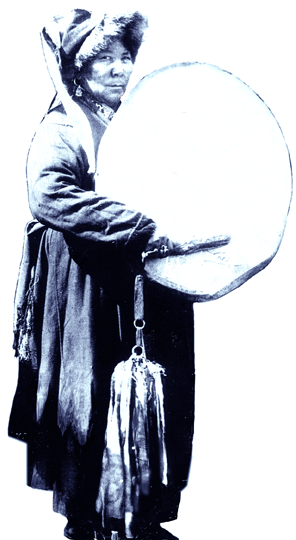woman shaman
 "I'm
a woman who looks toward the inside...
"I'm
a woman who looks toward the inside...
I'm a woman who knows how to swim in
the sacred..."
---Maria Sabina, Mazatec curandera, Mexico
Drummers, dreamers, diviners. Oracles, seers, and prophets.
Medicine women, healers, curanderas, and herbalists.
Women who invoke spirit. Rainmakers.
Ecstatic dancers, shapeshifters, sky-goers.
A comprehensive global view of female spiritual powers,
from chant and sacramental dance to shamanic flight.Woman is by nature a shaman, says a Chukchee proverb in northeastern Siberia, and many ethnic traditions say that the first shaman was female. This presentation may be the most comprehensive visual record of female shamans worldwide, from ancient times to the present. It encompasses Saharan and South African rock art, Greek ceramic paintings, Aztec manuscripts, Chinese bronzes, clay sculptures from ancient Ecuador and Iraq, soapstone sculptures from Alaska and ivory from Greenland, and modern photographs from all over the world.
"The shamanistic ceremony dedicated to the setting sun was usually performed by a woman." --Ivanov, Smolyak and Levin, "The Udegeys," in The Peoples of Siberia, 1964
SOME TITLES OF TRADITIONALLY FEMALE SHAMANS:
Machi (Chile). Wu (China). Azti (Euskadi/Basque). Tungutu (Bosso, Niger river). Mambo (Haiti). Appiltu (ancient Iraq). Eem (Karok, California). Völva (Norse). Mutang (Korea). Sangoma (!Xhosa). Qadeshah (ancient Israel). Belian (Indonesia). Ka'asnaschay (Paraguay). Mkah-'gro-ma (Tibet). Vyed'ma (Russia). Kahina (Tunisia). Mikogami (Japan). Paje (Panama). Halioruna (Gothic). Shesha (Ethiopia). Koekchuch (Kamchatka). Llü-bu (Yunnan). Melissa (Greece). Bori Magadjiya (Hausa). Mae de Santo (Brazil). Nat kadau (Burma). Mang'adzi or Makewana (Malawi). Babaylan, Catalonan, Anitera (Philippines). Bajasa (Toradja, Sulawesi).
More about female spiritual leaders.